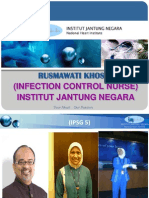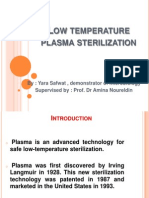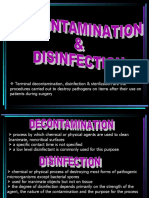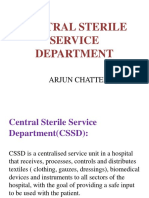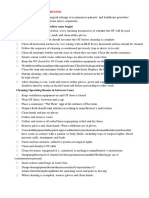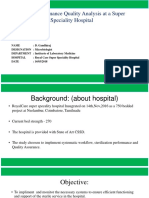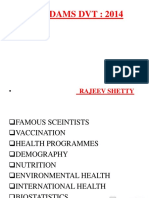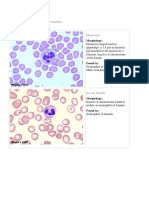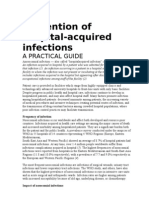Central Sterile Supply Department
Central Sterile Supply Department
Uploaded by
Vikas DhyaniCopyright:
Available Formats
Central Sterile Supply Department
Central Sterile Supply Department
Uploaded by
Vikas DhyaniCopyright
Available Formats
Share this document
Did you find this document useful?
Is this content inappropriate?
Copyright:
Available Formats
Central Sterile Supply Department
Central Sterile Supply Department
Uploaded by
Vikas DhyaniCopyright:
Available Formats
WELCOME
CSSD OVERVIEW
This Department is Heart of any Hospital as it receive impure (Used patient care and reprocessible) supplies, purifilies (Decontaminates ,cleans,assembles,packs and sterilizes) and supplies pure (Sterile) material to patient care areas.
To provide sterilized material to all the patient care area from single department where cleaning & sterilized practice are conducted under conditions, which are controlled, there by contributing to reduction of Hospital acquired Infections. To Give More Prompt service to the user department so they can devote more time to theirs patient care activities. To avoid duplication of costly equipment's which may be infrequently used.
To maintain record of effectiveness of sterilization process. To maintain proper inventory of supplies & equipment. To stay updated regarding development in the field of sterilization with the interest of effiency,economy accuracy and provision for the better patient care. To provide a safe environment for the patient & staff.
Step 3TRANSPORT
USE
TRANSPORT
STERILE STORAGE
QUALITY ASSURANCE
CLEANING /DISINFECTION
STERILIZATION
INSPECTION & TRAY ASSEMBLY
PACKAGING
CSSD WORK FLOW
Used Instruments From Wards
Used Instrument from OT
Receiving through receiving Window
Through Unsterile Lift
Decontamination Area
Visual Inspection For Damage
Manual Cleaning
Mechanical Cleaning Washer Disinfector/Ultrasonic
Drying of Instruments
Check for Functionality
Assembling & Packing of Instruments into respective Sets (Pack)
ETO Sterilization
Steam Sterilization
Recycling of Load
Confirm Sterility
During Sterilization Failure Storage in Sterile Area
Dispatch
Pick up at delivery Counter
Through Sterile Dumbwaiter
Wards
O.T.
Receiving Area (Cleaning Zone) Processing Area (Instrument Assembling Zone) Sterile Zone
Cleaning is the first & most important step in the sterilization process We can clean without sterilizing, but cannot sterilize without cleaning & we can clean without disinfecting but cannot disinfect without cleaning So cleaning is a critical step in decontamination, and it must be done effectively and timely.
Cleaning is the removal of both visible and nonvisible soil(such as blood,protine substance, and other debris) from the surface,crevices,joints,and lumens of instrument,devices,and equipment-usually with a detergent and water.
DECONTAMINATION
Decontamination is the use of physical or chemical procedure to remove, nactive,or destroy blood-borne pathogens on a surface or item. The purpose of decontamination is to make devices safe to handle for people who are not wearing gloves.
Disinfection kills or reduce the number f pathogenic microorganism on the surface of inanimate surface the level of disinfection required depends upon the purpose for which the item last used, and the purpose for which it will next be used.
IMPORTANCE OF CLEANING Surgical instrument that has not been properly cleaned after use can load to post operative complication, include infection. if it is not clean, it cannot be sterile Heat sensitive item that has not been properly clean & dry it can be react with ETO to form ethylene glycol, which is a toxic acid.
The cleaning and decontamination cycle for the surgical instruments and medical devices starts at the point of use. Instrument that have been soiled by patient blood and protein should be put into the cleaning process as soon as possible. Step 1-Rinsing with tap water immediately after use at the point of use. Step 2-The item should be transported to the CSSD Receiving area within 15 to 60 minute.
I.
Step 3-Complete disassembly and opening the hinge joints of the surgical instrument. Step 4-pre inspection is performed prior to placing instruments in the automated washer. Step 5-cleaning by manual or automated methods. Manual cleaning:-use friction to physically remove deposits that were only softened and not remove during pre-soaking .manual cleaning may be done: Using nylon bristle brushes is an effective way to remove bio-burden from instrument jaw serrations and box hinges. always use the correct size brush, when cleaning a lumen.
Automated washer:-Automated washer are effective
for cleaning instrumentation, instrument container,basins,bowls,and pitcher. They should not ,however ,be used to wash electrical ,battery-operated or pneumatic devices. Washer effectively disinfect instrument through thermal action (Heat) Ultrasonic Cleaners:-Ultrasonic cleaners are effective for cleaning instrument with delicate structure which cannot withstand mechanical force and having complex design that cannot be easily cleaned.
All instrument and devices are correctly packed as per the method of sterilization, to contain and protect the product, to facilitate sterilization, to maintain sterility while storing and transporting and to allow procedure to be carried out aseptically while using for patient care. Labeling:- Label is clearly written with the titles include the pack contents. The label include date of expiry and signature of the packed by
Policy- All Sterile packs are having a sequential batch number to enable batch traceability and /or recall. Batch Number_ The batch label indicates the following details1. Date of Sterilization 2. Date of Expiry 3. Sterilizer Number 4. Process/Cycle Number This is to facilitate batch traceability and recall of all the items expired or in the event of a sterilization failure.
Recall may be necessary while the sterile items are not being used within the date of expiry. The User Department is responsible for checking their stock of expiry in daily basis. Any item found expiring will be removed from the stock prior to one day of the expiry date and send back to CSSD receiving counter for reprocessing. A replacement of the same is issued to the department from sterile issue counter. Recall may be necessary during a process failure which is subsequently required to process all the items in the same load-the user will be informed by through phone and through e-mail.
Indicators are used for check the quality of sterilization & monitoring of the sterilization process. Indicators are two types
Physical indicator- Physical indicator are used for monitoring of sterilization process-like that Print out,gauge,and graph of sterilization machine. Chemical Indicator-These indicator also used for monitoring of sterilization and quality purpose. we are using many types of Indicators. Biological Indicator-Biological Indicator are used for control the quality of the sterile packs. Geo bacillus sterothermophilus are used in BI Indicator.
1-Phycical indicator 2-Chemical indicator 3-Biological Indicator
CLASS 1 INDICATOR-Autoclave tape(Labling tape) these indicator
are called Process indicator, it will be color change after processing.
Category of chemical indicator are divided into 6 Classes .
CLASS 2 INDICATOR- Bowie & Dick Testethese indicator are used for quality of Air Removal Teste.
CLASS 3 INDICATOR-These are single
parameter indicators used mainly in the industry for recording the exact temperature in a water bathe Temp Tubes CLASS 4 INDICATOR -These indicator are also called as multi parameter indicators as they confirm to two or more parameters, they confirm to quality of steam and time or temperature.
CLASS 5 INDICATOR-These indicator also called as a integrator, as they integrate all temperature and time over 110C in this temperature spores start to be eliminated. CLASS 6 INDICATOR-Class 6 indicator are called the emulating indicators and they change colors only on stead value like 121C for 15 minute and 134C for 4 minute. they are said to be the most stringent indicator and is more difficult to pass than a class 5 indicator. A class 6 indicator is said to integrate all the critical parameters of a process (VIZ) steam quality, Time and Temperature.
STERILIZATION IS THE PROCESS OF KILLING ALL MICROBIAL LIFE LIKE THAT VIRUS, BACTERIA,FUNGI INCLUDING SPORE FROM THE MEDICAL DEVICES We are doing three types of sterilization1. Steam sterilization (Steam) 2. Gas Sterilization (ETO) 3. Chemical Sterilization (Cydex)
You might also like
- Sterile Processing ChecklistDocument4 pagesSterile Processing Checklistamin138ir100% (2)
- Central Sterile Tech 1 Practice TestDocument8 pagesCentral Sterile Tech 1 Practice Testjerimiah_manzonNo ratings yet
- CSSDDocument5 pagesCSSDakshidrajNo ratings yet
- Phlebotomy Final Exam Practice Flashcards - Easy NotecardsDocument70 pagesPhlebotomy Final Exam Practice Flashcards - Easy NotecardsTalo Mj100% (3)
- Test Bank For Microbiology A Clinical Approach 2nd Edition Chapters 1 26 StrelkauskasDocument6 pagesTest Bank For Microbiology A Clinical Approach 2nd Edition Chapters 1 26 StrelkauskasDorothy Laclair100% (46)
- Autoclave Cleaning Log Sheet ExampleDocument23 pagesAutoclave Cleaning Log Sheet Exampleankit7588No ratings yet
- Central Sterile Supply DepartmentDocument23 pagesCentral Sterile Supply DepartmentXee Jay86% (7)
- CSSD Policy1Document58 pagesCSSD Policy1Namdev Suryawanshi100% (1)
- Infection Control ChecklistDocument11 pagesInfection Control Checklistmay88_9850% (2)
- Standard Operating Procedure For CSSDDocument10 pagesStandard Operating Procedure For CSSDsreejths96% (25)
- CRCST 136Document5 pagesCRCST 136jerimiah_manzonNo ratings yet
- CSSD SupervisorDocument6 pagesCSSD SupervisorNuman Khan100% (1)
- 24, Standards For Blood Banks and Blood Transfusion ServicesDocument111 pages24, Standards For Blood Banks and Blood Transfusion ServicesShiv Shankar Tiwari67% (3)
- CSSD - Sep 1st 2016 Final 3 in 1-1Document16 pagesCSSD - Sep 1st 2016 Final 3 in 1-1SundaraBharathiNo ratings yet
- Central Sterile and Supply DepartmentDocument26 pagesCentral Sterile and Supply Departmentshim50% (4)
- Basics of Steam SterilizationDocument6 pagesBasics of Steam SterilizationroberifinNo ratings yet
- CSSD PresentationDocument23 pagesCSSD PresentationNirali Sheth91% (22)
- CSSDDocument25 pagesCSSDbalachanderNo ratings yet
- Central Sterile Supply Department: Mallikarjuna MHADocument25 pagesCentral Sterile Supply Department: Mallikarjuna MHAsandhyakrishnanNo ratings yet
- Dr. Kasim Khot Mrs. Preeti JadhavDocument13 pagesDr. Kasim Khot Mrs. Preeti JadhavAbhi JeetNo ratings yet
- CSSDDocument90 pagesCSSDNikhil MohananNo ratings yet
- Aseptic TechniqueDocument9 pagesAseptic Techniquebethh_6No ratings yet
- Infection Control in CSSDDocument44 pagesInfection Control in CSSDAzira Afzan100% (1)
- CSSDDocument4 pagesCSSDjerimiah_manzon100% (1)
- CSSD Safety PDFDocument4 pagesCSSD Safety PDFhhato2100% (5)
- Central Sterile Supply DepartmentDocument5 pagesCentral Sterile Supply Departmentssbansod100% (4)
- CISDocument4 pagesCISjerimiah_manzonNo ratings yet
- CSSD Central Sterile Supply DepartmentDocument35 pagesCSSD Central Sterile Supply DepartmentAnsari Shariq0% (1)
- CSSD RCRD KeepingDocument4 pagesCSSD RCRD KeepingsattichenNo ratings yet
- CSSD PPT FinalDocument16 pagesCSSD PPT FinalnikhilNo ratings yet
- CSSD Overview PPT NotesDocument5 pagesCSSD Overview PPT NotesPranali MhatreNo ratings yet
- CSSD FunctonalityDocument5 pagesCSSD Functonalitya_kiytNo ratings yet
- Sterilization: Click To Edit Master Subtitle StyleDocument43 pagesSterilization: Click To Edit Master Subtitle Stylesalinderkaur100% (1)
- Cis 232Document5 pagesCis 232jerimiah_manzonNo ratings yet
- Lesson 124Document5 pagesLesson 124jerimiah_manzonNo ratings yet
- CSSDDocument43 pagesCSSDMohd SalahuddinNo ratings yet
- Operation Theatre DisciplineDocument16 pagesOperation Theatre DisciplineDr. Ghauri100% (9)
- Plasma Sterilizer 27-2-11 AmDocument29 pagesPlasma Sterilizer 27-2-11 AmYara Safwat100% (1)
- 8 Decontamination Disinfection SterilizationDocument8 pages8 Decontamination Disinfection SterilizationJay Villasoto100% (1)
- Central Sterile ServiceDocument75 pagesCentral Sterile ServiceSUBHENDU SIKDAR100% (1)
- CSSD Manual-1 PDFDocument47 pagesCSSD Manual-1 PDFTarun Bhattacharjee100% (1)
- Central Service Technical Manual: Seventh EditionDocument103 pagesCentral Service Technical Manual: Seventh EditionFarhan Ali100% (4)
- Checklist For CSSD For NABH Preparation and Its Quality IndicatorsDocument3 pagesChecklist For CSSD For NABH Preparation and Its Quality IndicatorsSanjay Kadam100% (3)
- AORN Sterilization RecommendationDocument13 pagesAORN Sterilization RecommendationBingDelaCruzNo ratings yet
- Operation Theater Policies and Procedures ManualDocument33 pagesOperation Theater Policies and Procedures Manualakinrav50% (2)
- Sterilization and DisinfectionDocument80 pagesSterilization and Disinfectiondr parveen bathlaNo ratings yet
- Final HICC Manual AIIMSDocument35 pagesFinal HICC Manual AIIMSNaMakNo ratings yet
- Steam SterilizationDocument2 pagesSteam SterilizationHumayun KhanNo ratings yet
- Getinge 46-x Washer Disinfector - User ManualDocument20 pagesGetinge 46-x Washer Disinfector - User ManualDodik E. PrasetyoNo ratings yet
- Cleaning of OtDocument7 pagesCleaning of Otvinod balajiNo ratings yet
- CSSD CPT ManualDocument3 pagesCSSD CPT Manualthirsal2003No ratings yet
- Cis Self-Study Lesson Plan: Care and Handling of Sharp InstrumentsDocument4 pagesCis Self-Study Lesson Plan: Care and Handling of Sharp Instrumentsjerimiah_manzonNo ratings yet
- CSSD Performance Quality Analysis at A Super Speciality HospitalDocument29 pagesCSSD Performance Quality Analysis at A Super Speciality HospitalD. GandhirajNo ratings yet
- Understanding Steam Sterilization GuideDocument17 pagesUnderstanding Steam Sterilization GuideGabriel Pacheco100% (1)
- Presentation 1 Environmental CleaningDocument33 pagesPresentation 1 Environmental CleaningAfeefa Amin AliNo ratings yet
- Cis Self-Study Lesson Plan: Otolaryngological InstrumentationDocument4 pagesCis Self-Study Lesson Plan: Otolaryngological Instrumentationjerimiah_manzonNo ratings yet
- Lesson 122Document4 pagesLesson 122jerimiah_manzonNo ratings yet
- Sterlization Procedures and DisinfectionDocument36 pagesSterlization Procedures and DisinfectionHarshinie AudimulamNo ratings yet
- Sterile Processing Technician ResumeDocument4 pagesSterile Processing Technician Resumeusuoezegf100% (1)
- CBSPD ISO Training ProgramDocument73 pagesCBSPD ISO Training ProgramPinco Pallino100% (2)
- Handbook for Cssd Technicians: Understanding the Basics - Second EditionFrom EverandHandbook for Cssd Technicians: Understanding the Basics - Second EditionNo ratings yet
- Veterinary Microbiology II:: Bovine Ephemeral Fever (BEF)Document22 pagesVeterinary Microbiology II:: Bovine Ephemeral Fever (BEF)Reza Alfitra MutiaraNo ratings yet
- Value Bases Maths Class 12Document16 pagesValue Bases Maths Class 12tabizhNo ratings yet
- Gonorrhea: 1. Disease ReportingDocument7 pagesGonorrhea: 1. Disease ReportingWahyudi Permana DarlisNo ratings yet
- Central Nervous System Infections 2024Document41 pagesCentral Nervous System Infections 2024aguilarjanicaNo ratings yet
- CorynebacteriumDocument60 pagesCorynebacteriumkanchana DNo ratings yet
- Infection Control GuidelinesDocument409 pagesInfection Control GuidelinesmopaselNo ratings yet
- DAMS PSM DVT 2014 and 2015-1-1-1Document197 pagesDAMS PSM DVT 2014 and 2015-1-1-1niranjan kishoreNo ratings yet
- Blood CellsDocument14 pagesBlood CellsrizaNo ratings yet
- Pest - of - Fruit - Final Citrus Etc PDFDocument134 pagesPest - of - Fruit - Final Citrus Etc PDFraghuyadavNo ratings yet
- Parasite Summary Table FinalDocument3 pagesParasite Summary Table FinalTamarah Yassin100% (1)
- Pharm MCQ BookDocument11 pagesPharm MCQ BookanojanNo ratings yet
- ShigelosisDocument7 pagesShigelosisDesy SulistiyoriniNo ratings yet
- Prevention of Hospital-Acquired Infections: A Practical GuideDocument61 pagesPrevention of Hospital-Acquired Infections: A Practical Guidedrkamani100% (1)
- Nursing Care PlanDocument4 pagesNursing Care PlanGabrielGitaNo ratings yet
- Lecture Notes SACCLDocument5 pagesLecture Notes SACCLNathaniel SimNo ratings yet
- CAP76OCTDocument240 pagesCAP76OCTotorreslNo ratings yet
- Opsoclonus Myoclonus Ataxia Syndrome Due To Mycobacterium Tuberculosis RhombencephalitisDocument6 pagesOpsoclonus Myoclonus Ataxia Syndrome Due To Mycobacterium Tuberculosis RhombencephalitisImmer Armendáriz BetancourtNo ratings yet
- Epidemiology LMSDocument5 pagesEpidemiology LMSkoreainhyukNo ratings yet
- Basic Microbiology Board ReviewDocument248 pagesBasic Microbiology Board ReviewWilson James DoblasNo ratings yet
- Gizzard Erosion in ChickDocument2 pagesGizzard Erosion in Chickdev100% (2)
- LeptospiraDocument4 pagesLeptospirapregipregoNo ratings yet
- Seminar ON: Infection Prevention (Including Hiv) and Standard Safety Measures, Bio - Medical Waste ManagementDocument24 pagesSeminar ON: Infection Prevention (Including Hiv) and Standard Safety Measures, Bio - Medical Waste ManagementTHONDYNALUNo ratings yet
- Review Parasitology Exam (Permanent Stain Images)Document12 pagesReview Parasitology Exam (Permanent Stain Images)Tony DawaNo ratings yet
- Globalization and SanitizationDocument14 pagesGlobalization and SanitizationlavugracefulNo ratings yet
- Approach To Joint PainDocument44 pagesApproach To Joint PainKavya Anoop100% (1)
- Microsoft Word - Schuessler Salts FlyerDocument2 pagesMicrosoft Word - Schuessler Salts Flyer4379100% (2)
- Bonus Vocabulary Questions - 2nd To 6th Grade - 75 Questions PASSWORD Wasibonus PDFDocument12 pagesBonus Vocabulary Questions - 2nd To 6th Grade - 75 Questions PASSWORD Wasibonus PDFAzzaya DashzevegNo ratings yet
























